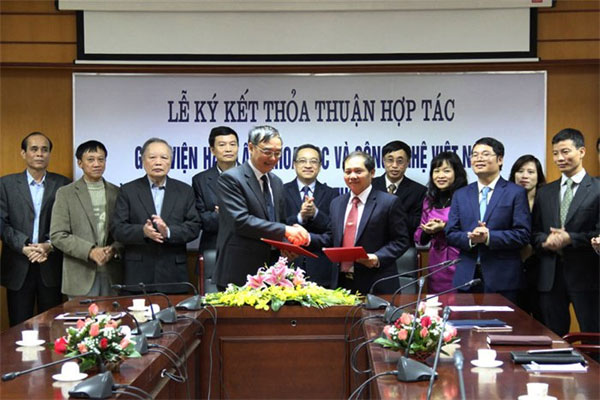
Representatives of the Vietnam Academy of Science and Technology and the Radio Frequency Department shake hands after exchanging a cooperation agreement in Hanoi on January 12
The plans were unveiled at a ceremony held in Hanoi on January 12 for the signing of a cooperation agreement between the Vietnam Academy of Science and Technology and the Radio Frequency Department under the Ministry of Information and Communications.
Speaking at the signing ceremony, Deputy Minister of Information and Communications Phan Tam said the satellite communication sector has strongly grown in Vietnam. The country currently has two operational telecom satellites and a remote sensing satellite in operation.
In 2008, Vietnam’s first telecom satellite VINASAT-1 was put into orbit and the second telecom satellite VINASAT-2 in 2012, with both invested by VNPT. In 2013, the first remote sensing satellite VNREDSat-1 of the Vietnam Academy of Science and Technology was successfully brought into space.
The academy is implementing projects for earth observation satellites including VNREDSat-2, LOTUSat-1 and 2. The new projects require close collaboration between the department and the academy, especially in registration and international frequency coordination.
Mr. Tam said to obtain frequencies and orbit positions for satellites, countries must undertake registration and international frequency coordination when deploying new satellite projects to ensure no interference for the satellite system. For VNREDSat-1 project, Vietnam had to work with 16 countries and two satellite organizations.
Nguyen Dinh Cong, Vice Chairman of the academy, said according to the development strategy for the sector until 2020, Vietnam will implement national satellite projects with small observation satellites to be launched into orbit.
Doan Quang Hoan, Director of the Radio Frequency Department, said there are currently about 1,100 remote sensing and over 100 telecom satellites in orbit.
When launching a satellite into orbit, apart from complying with national regulations, countries must also comply with the requirements of the international agencies for cosmic development and the International Telecommunication Union (ITU). According to the rules of world radio communications, satellite frequencies must be shared in association with frequencies of other operations. Therefore, frequency agencies should study to obtain proper frequencies and use common frequencies to avoid affecting or interfering with remote sensing satellites.


